
Persistence & Retention – 2016
Of all students who started college in fall 2014, 72.1 percent persisted at any U.S. institution in fall 2015, while 60.6 percent were retained at their starting institution.
Overall Persistence Rate Improves for Third Straight Year
Of all students who started college in fall 2014, 72.1 percent persisted at any U.S. institution in fall 2015, while 60.6 percent were retained at their starting institution. The persistence rate is the percentage of students who return to college at any institution for their second year, while the retention rate is the percentage of students who return to the same institution. The overall persistence rate for the fall 2014 cohort was only 0.1 percentage points higher than that of the previous cohort, but was up 2.1 points since bottoming out in fall 2010. For students who started part-time, the rate has increased 2.9 points since 2010. For the included years, the overall persistence rate is about 11 percentage points higher, on average, than the retention rate. Thus, about one in nine students who start college in any fall term, transfer to a different institution by the following fall.
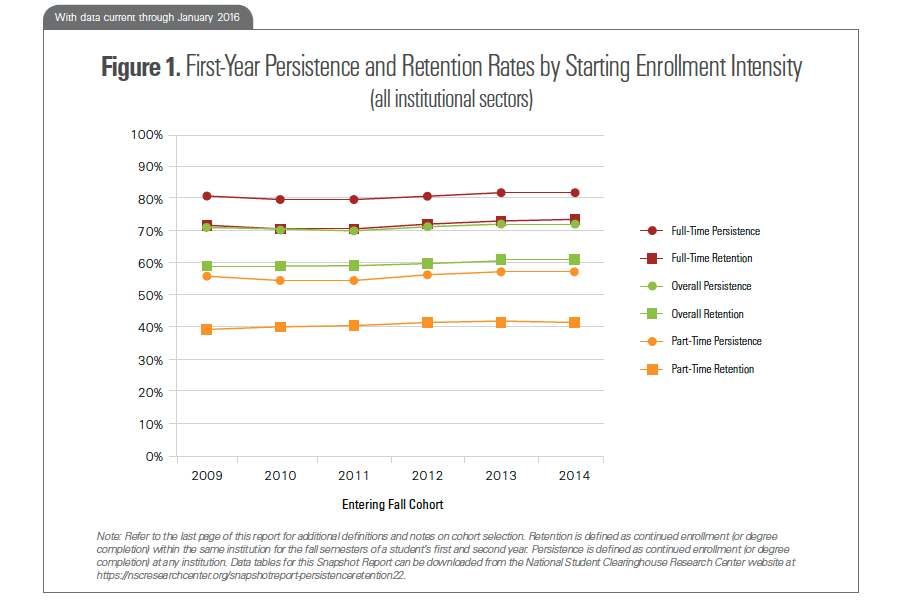
Students in the >20-to-24 Age Group Make Largest Gains in Persistence
Fall 2014 entering students who were in the >20-to-24 age group (at college entry) had a persistence rate of 54.9 percent. This represents an increase of 3.7 percentage points over the fall 2009 entering cohort. Students in the 20 and under age group had a persistence rate of 78.1 percent, down just 0.3 percentage points from the fall 2009 entering cohort. This group also showed the highest spread between persistence and retention rates, with about 14 percent, or one in seven students, enrolling in a different institution in their second year. Students who were over age 24 at college entry had a persistence rate of 50.5 percent, a figure that has remained essentially flat across the six cohorts shown in this report.
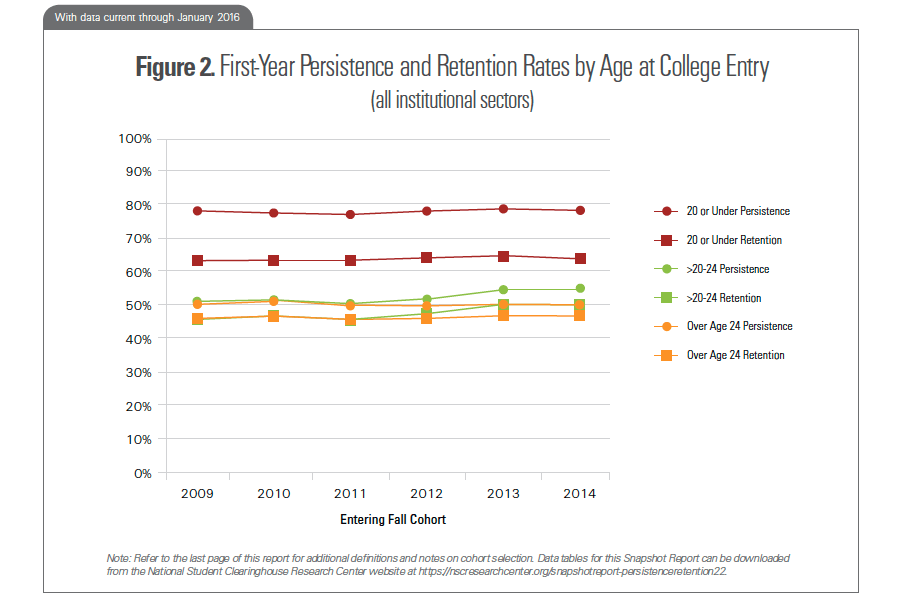
Four-Year Publics: Modest Gains Continue
For students who started college in four-year public institutions, the persistence rate was 82.3 percent, up 0.1 percentage points from the prior year, and up 0.5 percentage points in comparison to the fall 2009 cohort. Of all students who started college in this sector in fall 2014, 70.2 percent returned to the same institution in fall 2015. For students whose entering status was full-time, the persistence rate was 88.2 percent, up 0.2 percentage points from the prior year, and up 0.1 percentage points in comparison to the fall 2009 cohort. For students whose entering status was part-time in 2014, the persistence rate was 62.8 percent, 21.3 points higher than the retention rate.
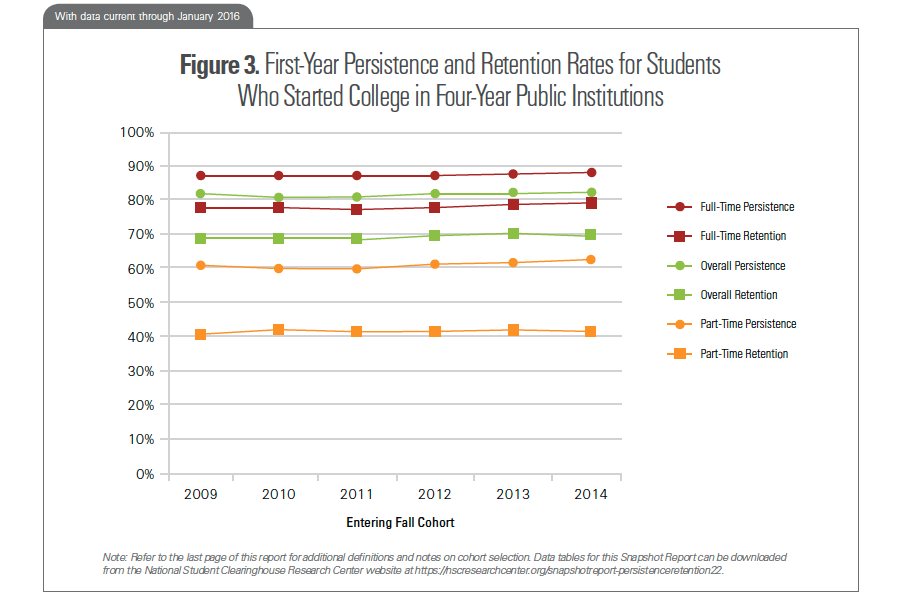
Four-Year Privates: Persistence Down Slightly
For students who started college in four-year private nonprofit institutions, the persistence rate was 86.7 percent, down 0.5 percentage points from the prior year, and down 0.6 percentage points in comparison to the fall 2009 cohort. Of all students who started college in this sector in fall 2014, 75.5 percent returned to the same institution. For students whose entering status was full-time, the persistence rate was 90.7 percent, down 0.3 percentage points from both the prior year and the fall 2009 entering cohort. For students whose entering status was part-time, the persistence rate was 60.4 percent, down 1.2 percentage points from the prior year, and down 3.2 percentage points in comparison to the fall 2009 cohort. (This group makes up less than 12 percent of the sector’s entering cohort.)
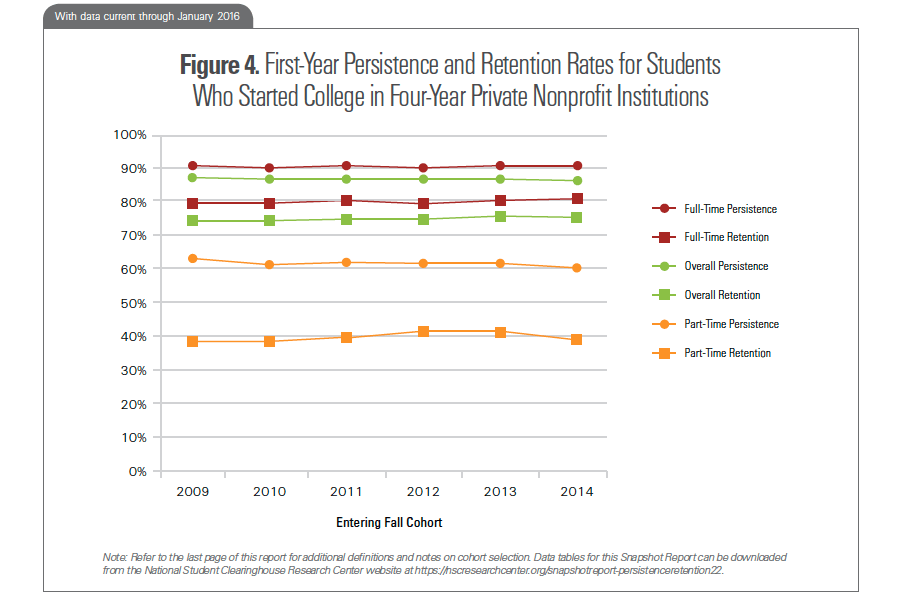
Four-Year For-Profits: Drop in Persistence
For students who started college in four-year for-profit institutions, the persistence rate was 49.3 percent, down 3.9 percentage points from the prior year, and down 1.4 percentage points in comparison to the fall 2010 cohort. Of all students who started college in this sector in fall 2014, 44.2 percent returned to the same institution. For students whose entering status was full-time, the persistence rate was 53.5 percent, down 5.4 percentage points from the prior year, and up 0.7 percentage points in comparison to the fall 2010 cohort. For students whose entering status was part-time, the persistence rate was 43.1 percent, down 1.1 percentage points from the prior year, and down 4.0 percentage points in comparison to the fall 2010 cohort.
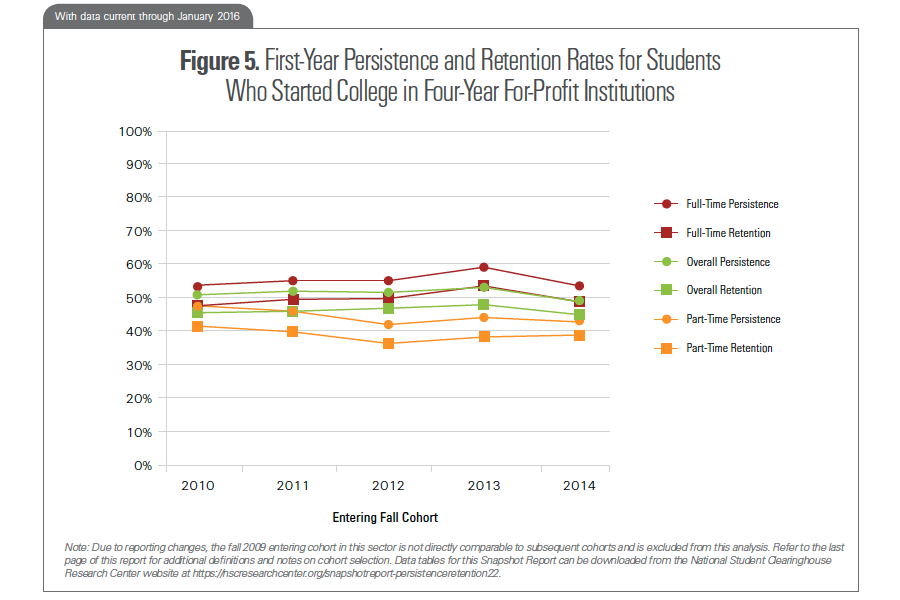
Two-Year Publics: Overall Persistence Reaches Six-Year High
For students who started college in two-year public institutions, the persistence rate was 60.0 percent, up 0.2 percentage points from both the prior year and in comparison to the fall 2009 cohort. Of all students who started college in this sector in fall 2014, 48.5 percent returned to the same institution. For students whose entering status was full-time, the persistence rate was 68.6 percent, up 0.7 percentage points from the prior year, but down 0.7 percentage points in comparison to the fall 2009 cohort. For students whose entering status was part-time, the persistence rate was 55.2 percent, up 0.3 percentage points from the prior year and up 1.6 percentage points in comparison to the fall 2009 cohort.
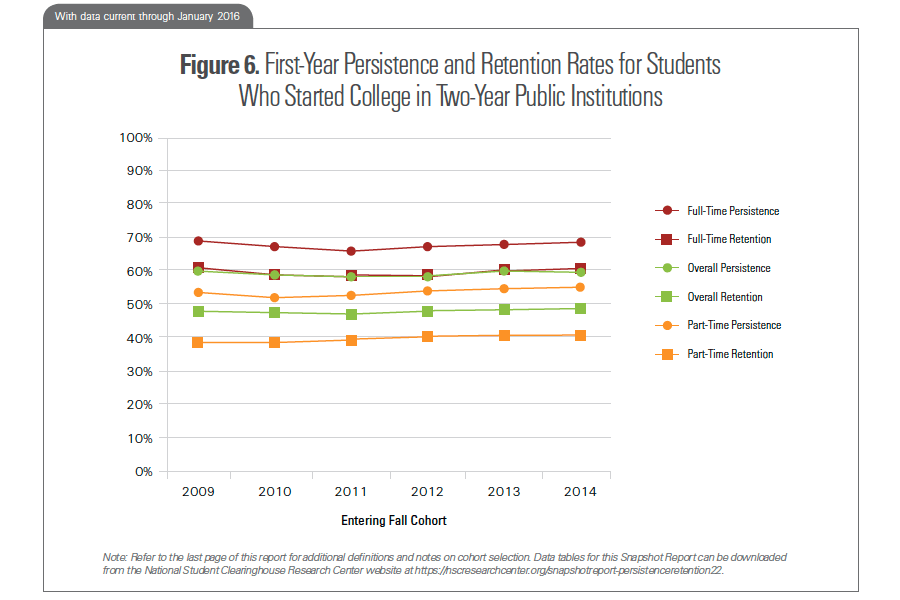
Definitions and Notes on Cohort Selection
International Students
Institutional reporting of international students to the Clearinghouse has steadily increased in recent years. In order to ensure consistent year-to-year comparisons, international students have been excluded from this report. Persistence and retention rates for the Fall 2009-Fall 2013 entering cohorts have been restated from previous editions of this report which did not make this exclusion. In 2014-15 (the most recent year for which IPEDS data are available), nonresident aliens made up about 4.5 percent of total enrollments.
Retention
Defined in this report as continued enrollment (or degree completion) within the same higher education institution in the fall semesters of a student’s first and second year.
Persistence
Defined in this report as continued enrollment (or degree completion) at any higher education institution — including one different from the institution of initial enrollment — in the fall semesters of a student’s first and second year.
Enrollment Intensity
A student is classified as having started college in a full-time status or part-time status based on their earliest reported enrollment intensity within the entering fall term. The part-time grouping comprises three-quarter-time, half-time and less-than-half-time students, some of whom may be non-degree-seeking.
First-Time Status
This report uses historical Clearinghouse enrollment and degree data to confirm that students included in the study (1) showed no previous college enrollment in the four years prior to the entering cohort year and (2) had not previously completed a college degree. In order to reliably identify students with prior enrollments, this report is limited to institutions that began submitting enrollment data to the Clearinghouse for terms beginning on or before June 1, 2005.
Institutional Sample
This report is based on a fixed panel of institutions for all six starting cohorts. These are U.S. Title IV degree-granting institutions that have been submitting student enrollment data to the Clearinghouse since at least June 1, 2005, representing approximately 87.6 percent of the total enrolled population as of fall 2014.
Degree-Seeking Status
The retention rates reported by IPEDS are limited to degree-seeking students. This report differs in that it includes all entering students.
Former Dual Enrollment Students
The cohorts used in this study include former dual enrollment students: first-time college students who had taken college courses prior to graduating from high school. Students were identified as former dual enrollment students if they were under 18 years of age during any enrollments that occurred prior to the cohort year.
Fall Enrollment
A student is counted as having been enrolled in the fall if they were enrolled for any length of time in a term that began between August 1 and October 31, inclusive.
